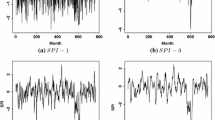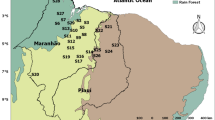Abstract
In this study, non-homogeneous Poisson processes (NHPP) are used to analyze climate data. The data were collected over a certain period time and consist of the yearly average precipitation, yearly average temperature and yearly average maximum temperature for some regions of the world. Different existing parametric forms depending on time and on unknown parameters are assumed for the intensity/rate function \(\lambda (t), t \ge 0\) of the NHPP. In the present context, the Poisson events of interest are the numbers of years that a climate variable measurement has exceeded a given threshold of interest. The threshold corresponds to the overall average measurements of each climate variable taking into account here. Two versions of the NHPP model are considered in the study, one version without including change points and one version including a change point. The parameters included in the model are estimated under a Bayesian approach using standard Markov chain Monte Carlo (MCMC) methods such as the Gibbs sampling and Metropolis–Hastings algorithms. The models are applied to climate data from Kazakhstan and Uzbekistan, in Central Asia and from the USA obtained over several years.







Similar content being viewed by others
Data Availability
See Appendix 1.
Code Availability
See Appendix 2.
References
Intergovernmental Panel on Climate Change. (2019). IPCC, 2018: Global Warming of 1.5\(^{\circ }\)C. An IPCC Special Report on the impacts of global warming of 1.5\(^{\circ }\)C above pre-industrial levels and related global greenhouse gas emission pathways, in the context of strengthening the global response to the threat of climate change, sustainable development, and efforts to eradicate poverty. V. Masson-Delmotte, P. Zhai, H.-O. Pörtner, D. Roberts, J. Skea, P.R. Shukla, A. Pirani, W. Moufouma-Okia, C. Péan, R. Pidcock, S. Connors, J.B.R. Matthews, Y. Chen, X. Zhou, M.I. Gomis, E. Lonnoy, T. Maycock, M. Tignor, and T. Waterfield (Eds.).
Joyce, L. A., & Birdsey, R. (2000). The impact of climate change on America’s forests: A technical document supporting the 2000 USDA Forest Service RPA Assessment. In L.A. Joyce, R. Birdsey (Eds.) Gen. Tech. Rep RMRS-GTR-59. Fort Collins, CO: U.S. Department of Agriculture, Forest Service, Rocky Mountain Research Station.
Doney, S. C., Ruckelshaus, M., Duffy, J. E., et al. (2012). Climate change impacts on marine ecosystems. Annual Review of Marine Sciences, 4, 11–37.
Gayton, D. V. (2008). Impacts of climate change on British Columbia’s biodiversity: A literature review. Extended Abstract. BC Journal of Ecosystems and Management, 9, 26-30.
Katz, R. W. (1996). Use of conditional stochastic models to generate climate change scenarios. Climate Change, 32, 237–255.
Majda, A. J., Tomofeyev, I., & Eijnden, E. V. (2001). A mathematical framework for stochastic climate models. Communications on Pure and Applied Mathematics LIV, 891–974.
Rajagopalan, B., Lall, U., & Tarboton, D. G. (1984). A non parametric renewal model for modeling daily precipitation. In K.W. Hipel, A.I. McLeod, U.S. Panu, V.P. Sing (Eds.) Stochastic and Statistical Methods in Hydrology and Environmental Engineeing, 4, 47-59.
Outayek, S. E., & Nguyen, V. -T. -V. (2019) Stochastic modeling of daily rainfall process in the context of climate change. In: CSCE Annual Conference.
Franzke, C. L. E., O’Kane, T. J., Bener, J., Williams, P. D., & Lucarini, V. (2015). Stochastic climate theory and modeling. WIRES Climate Change, 6, 63–78.
Alexander, L. V., Zhang, X., Peterson, T. C., Caesar, J., Gleason, B., Klein Tank, A., Haylock, M., Collins, D., Trewin, B., Rahimzadeh, F., et al. (2006). Global observed changes in daily climate extremes of temperature and precipitation. Journal of Geophysical Research: Atmospheres, 111(D5).
Foley, A. (2010). Uncertainty in regional climate modelling: A review. Progress in Physical Geography, 34(5), 647–670.
Powell, B. (2016). Chapter 22 - Statistical modelling of climate change. In: Climate Change. Elsevier, 341–354.
Richards, G. R. (1993). Change in global temperature: A statistical analysis. Journal of Climate, 6(3), 546–559.
Achcar, J. A., Rodrigues, E. R., Paulino, C. D., & Soares, P. (2010). Non-homogeneous Poisson models with a change-point: An application to ozone peaks in Mexico City. Environmental and Ecological Statistics, 17(4), 521–541.
Achcar, J. A., & Sicchieri, M. P. L. (2010). da Silva: Comparação de modelos para os excessos de internações hospitalares diárias por pneumonia na cidade de São Paulo. (In Portuguese) Revista Brasileira de Biometria, 28, 87-103.
Achcar, J. A., Rodrigues, E. R., & Tzintzun, G. (2011). Using non-homogeneous Poisson models with multiple change-points to estimate the number of ozone exceedances in Mexico City. Environmetrics, 22(1), 1–12.
Coelho-Barros, E. A., Achcar, J. A., Martinez, E. Z., Davarzani, N., & Grabsh, H. I. (2019). Bayesian inference for segmented Weibull distribution. Revista Colombiana de Estadística, 42, 225–243.
Puziol de Oliveira, R., Chen, C., & Achcar, J. A. (2018). Bayesian estimation for change-points in counting time series: a unified approach using linear regression model and non-homogeneous Poisson processes. In: Workshop de Bioestatística, 05-07 December 2018, Maringá-PR, Brazil.
Achcar, J. A. (2001). Ch. 29. Bayesian analysis for software reliability data. Handbook of Statistics, 20, 733–748.
Achcar, J. A., Dey, D .K., & Niverthi, M. (1998). A Bayesian approach using nonhomogeneous Poisson process for software reliability models. In Frontiers in Reliability, Basu, SK, Mukhopadhyay, S. (eds.); Series on Quality, Reliability and Engeneering Statistics 4; Calcutta University; India
Cid, J. E. R., & Achcar, J. A. (1999). Bayesian inference for nonhomogeneous poisson processes in software reliability models assuming nonmonotonic intensity functions. Computational Statistics & Data Analysis, 32(2), 147–159.
Wilson, S. P., & Costello, M. J. (2005). Predicting future discoveries of european marine species by using a non-homogeneous renewal process. Journal of the Royal Statistical Society: Series C (Applied Statistics), 54(5), 897–918.
Guarnaccia, C., Quartieri, J., Tepedino, C., & Rodrigues, E. R. (2015). An analysis of airport noise data using a non-homogeneous Poisson model with a change-point. Applied Acoustics, 91, 33-39.
Achcar, J., Martinez, E., Ruffino-Netto, A., Paulino, C., & Soares, P. (2008). A statistical model investigating the prevalence of tuberculosis in new york city using counting processes with two change-points. Epidemiology & Infection, 136(12), 1599–1605.
Achcar, J. A., & Loibel, S. (1998). Constant hazard function models with a change point: A Bayesian analysis using Markov chain Monte Carlo methods. Biometrical Journal: Journal of Mathematical Methods in Biosciences, 40(5), 543–555.
Kuo, L., & Yang, T. Y. (1996). Bayesian computation for nonhomogeneous Poisson processes in software reliability. Journal of the American Statistical Association, 91(434), 763–773.
Pievatolo, A., & Ruggeri, F. (2004). Bayesian reliability analysis of complex repairable systems. Applied Stochastic Models in Business and Industry, 20(3), 253–264.
Achcar, J. A., & Bolfarine, H. (1989). Constant hazard against a change-point alternative: A Bayesian approach with censored data. Communications in Statistics-Theory and Methods, 18(10), 3801–3819.
Carlin, B. P., Gelfand, A. E., & Smith, A. F. (1992). Hierarchical Bayesian analysis of changepoint problems. Journal of the Royal Statistical Society: Series C (Applied Statistics), 41(2), 389–405.
Dey, D. K., & Purkayastha, S. (1997). Bayesian approach to change point problems. Communications in Statistics-Theory and Methods, 26(8), 2035–2047.
Raftery, A. E., & Akman, V. (1986). Bayesian analysis of a Poisson process with a change-point. Biometrika, 85–89.
Ruggeri, F., & Sivaganesan, S. (2005). On modeling change points in non-homogeneous Poisson processes. Statistical Inference for Stochastic Processes, 8(3), 311–329.
Gyarmati-Szabó, J., Bogachev, L. V., & Chen, H. (2011). Modelling threshold violations of air pollution concentrations using multiple change-points Poisson process. Atmospheric Environment, 45, 5493–5503.
Chib, S., & Greenberg, E. (1995). Understanding the Metropolis-Hastings algorithm. The American Statistician, 49(4), 327–335.
Gelfand, A. E., & Smith, A. F. (1990). Sampling-based approaches to calculating marginal densities. Journal of the American Statistical Association, 85(410), 398–409.
Smith, A. F., & Roberts, G. O. (1993). Bayesian computation via the Gibbs sampler and related Markov chain Monte Carlo methods. Journal of the Royal Statistical Society: Series B (Methodological), 55(1), 3–23.
Spiegelhalter, D. J., Thomas, A., Best, N., & Lunn, D. (2003). WinBUGS version 1.4 user manual. MRC Biostatistics Unit, Cambridge. URL: http://www.mrc-bsu.cam.ac.uk/bugs.
Oliveira, R. P., Achcar, J. A., Mazucheli, J., & Bertoli, W. (2021). A new class of bivariate Lindley distributions based on stress and shock models and some of their reliability properties. Reliability Engineering & System Safety, 211, 107528.
Yang, T. Y. (1994). Computational approaches to bayesian inference for software reliability. PhD Thesis, Department of Statistics, University of Connecticut, Storrs, USA.
Crow, L. H. (1974). Reliability analysis for complex repairable systems. In: Proschan, F., Serfling, R. J. (Eds.). Reliability and Biometry, 379–410.
Crow, L. H. (1982). Confidence interval procedures for the Weibull process with applications to reliability growth. Technometrics, 24(1), 67–72.
Musa, J. D., & Okumoto, K. (1984). A logarithmic Poisson execution time model for software reliability measurement. In: Proceedings of the 7th international Conference on Software Engineering. Citeseer, 230–238.
Goel, A., & Okumoto, K. (1978). An analysis of recurrent software failures in real-time control system. In: Proceedings of ACM Conference. Washington, 496–500.
Cancho, V., Bolfarine, H., & Achcar, J. (1999). A Bayesian analysis for the exponentiated-Weibull distribution. Journal Applied Statistical Science, 8(4), 227–42.
Mudholkar, G. S., Srivastava, D. K., & Freimer, M. (1995). The exponentiated Weibull family: A reanalysis of the bus-motor-failure data. Technometrics, 37(4), 436–445.
Weibull, W., et al. (1951). A statistical distribution function of wide applicability. Journal of Applied Mechanics, 18(3), 293–297.
Kotz, S., Balakrishnan, N., & Johnson, N. L. (2004). Pareto distributions. Continuous multivariate distributions, Volume 1: Models and applications. John Wiley & Sons.
Lomax, K. S. (1954). Business failures: Another example of the analysis of failure data. Journal of the American Statistical Association, 49(268), 847–852.
Cox, D. R., & Lewis, P. A. (1996). Statistical analysis of series of events. U.K.: Methuem.
Spiegelhalter, D. J., Best, N. G., Carlin, B. P., & Van Der Linde, A. (2002). Bayesian measures of model complexity and fit. Journal of the Royal Statistical Society: Series B (Statistical Methodology), 64(4), 583–639.
Williams, M., & Konovalov, V. (2008). Central Asia temperature and precipitation data, 1879–2003. Boulder, Colorado: USA National Snow and Ice Data Center. https://doi.org/10.7265/N5NK3BZ8. [Accessed in 10/20/2020].
Carlin, B. P., & Louis, T. A. (2000). Bayes and empirical Bayes methods for data analysis. Chapman & Hall/CRC.
Laub, P. J., Taimre, T., & Pollett, P. K. (2015). Hawkes processes. In arXiv:1507.02822v1.
Acknowledgements
The authors are grateful to an anonymous reviewer for the comments and suggestions which helped to improve the presentation of the results and also for suggesting the work about Hawkes processes. The authors are also grateful to Dr Eliane R. Rodrigues for a review of the manuscript and important comments that led to the great improvement of the article.
Funding
Not applicable.
Author information
Authors and Affiliations
Contributions
Jorge Alberto Achcar and Ricardo Puziol de Oliveira contributed to revision, writing, analysis and methodology.
Corresponding author
Ethics declarations
Conflicts of Interest/Competing Interests
There is no conflict of interest.
Additional information
Publisher’s Note
Springer Nature remains neutral with regard to jurisdictional claims in published maps and institutional affiliations.
Appendices
Appendix 1
Appendix 2

Rights and permissions
About this article
Cite this article
Achcar, J.A., de Oliveira, R.P. Climate Change: Use of Non-Homogeneous Poisson Processes for Climate Data in Presence of a Change-Point. Environ Model Assess 27, 385–398 (2022). https://doi.org/10.1007/s10666-021-09797-z
Received:
Accepted:
Published:
Issue Date:
DOI: https://doi.org/10.1007/s10666-021-09797-z




